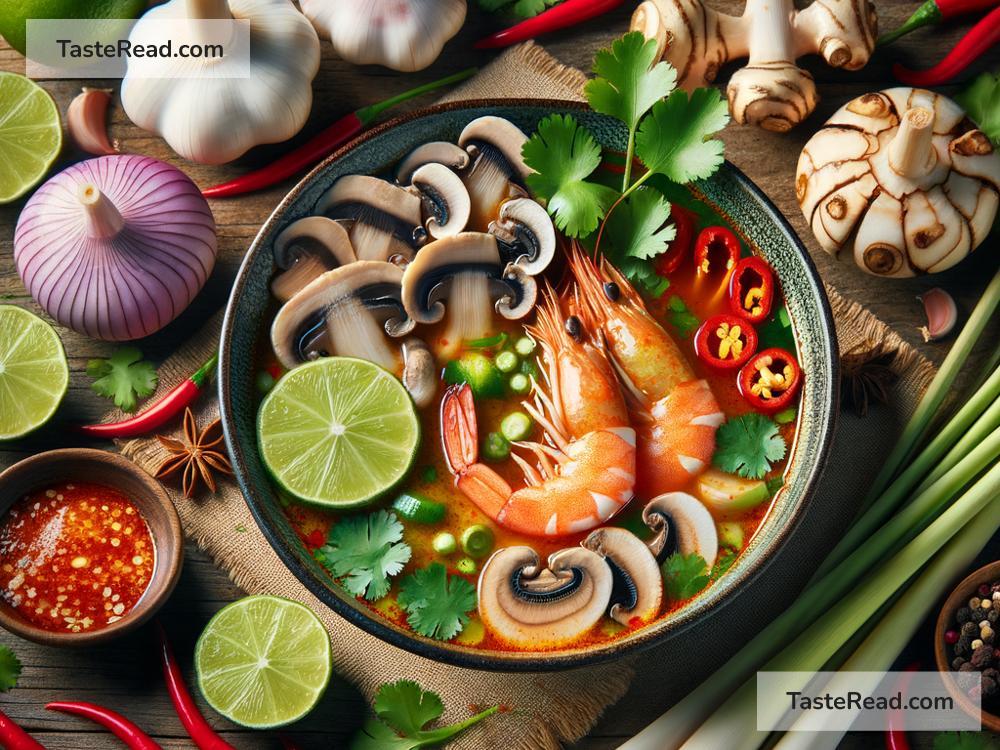The Influence of Thai Tom Yum: A Tangy Tale of Global Flavor
When you think about Thai food, one dish stands out for its bold flavors and unforgettable taste—Tom Yum. This spicy and sour soup has captured the hearts (and taste buds) of people all over the world. Whether you’re dining at a local Thai restaurant or enjoying instant noodles at home, Tom Yum’s influence stretches far beyond Thailand. But what makes this dish so special? How did it become a global culinary icon? Let’s explore the story behind Tom Yum and its worldwide impact.
What is Tom Yum?
Tom Yum is a traditional Thai soup known for its unique balance of flavors—spicy, sour, salty, and a hint of sweetness. Its name comes from two words in Thai: “Tom” means to boil and “Yum” refers to the process of combining ingredients to create a flavorful dish. The soup usually includes shrimp (Tom Yum Goong), chicken (Tom Yum Gai), or a mix of vegetables for a vegetarian version. The broth is where the magic happens, typically made with ingredients like lemongrass, kaffir lime leaves, galangal (a type of ginger), chili, fish sauce, lime juice, and tamarind. These herbs and spices create a fragrant, aromatic dish that’s both refreshing and comforting.
The Cultural Importance of Tom Yum
In Thailand, food is more than sustenance—it’s a way of life. Traditional dishes like Tom Yum play an important role in the country’s culture, passed down through generations as family recipes. For Thai people, cooking is about creating harmony and balance in flavors. Tom Yum perfectly captures this philosophy by blending spicy heat with tangy freshness.
Tom Yum is also a dish that brings people together. In Thailand, sharing food is a communal activity that strengthens relationships. Whether you’re at a street food stall or hosting a family dinner, a steaming bowl of Tom Yum is often at the center of the table. Its vibrant colors and bold aroma invite conversation and connection, making it more than just a meal—it’s an experience.
Spreading Across Borders: The Rise of Tom Yum Globally
Thai cuisine became popular internationally in the late 20th century, thanks to travelers who fell in love with the country’s unique dishes. Restaurants serving Thai food started popping up in cities around the world, and Tom Yum was often a highlight of the menu. People were drawn to its bright, complex flavors that stood out from dishes in other cuisines.
One of the reasons for its global success is its adaptability. Tom Yum can be customized to suit different tastes and dietary restrictions. While traditional recipes remain popular, fusion versions have also emerged. In countries like the United States and Australia, chefs have experimented with adding local ingredients to the soup, including mushrooms, lobster, or even pasta. Despite these tweaks, the soul of the dish—the tangy broth and fresh herbs—remains unchanged.
Another major factor in Tom Yum’s worldwide fame is the rise of instant noodles. In Asia and beyond, brands like Mama and Nongshim offer Tom Yum-flavored noodles, making it easy for people to enjoy the soup’s iconic taste in minutes. For busy individuals and students, these instant versions provide a convenient way to experience Thai cuisine on the go.
The Health Benefits of Tom Yum
Tom Yum isn’t just delicious—it’s also packed with health benefits. Many of the ingredients used in the soup have medicinal properties. For instance:
- Lemongrass is known for its anti-inflammatory and immune-boosting effects.
- Galangal and ginger aid digestion and promote healthy circulation.
- Chili contains capsaicin, which may improve metabolism and reduce inflammation.
- Kaffir lime leaves are rich in antioxidants, supporting overall wellness.
Additionally, Tom Yum is low in calories and fat, making it a smart choice for those who are health-conscious. Many people even consider it a go-to meal when they feel under the weather, thanks to its soothing warmth and healing herbs.
Tom Yum in Modern Food Trends
As global food culture evolves, Tom Yum continues to inspire creativity among chefs and food enthusiasts. Its influence can be seen in fusion dishes like Tom Yum burgers, pizzas, and fried rice. Even cocktails have been created using Tom Yum-inspired ingredients, such as lemongrass-infused vodka and chili syrup.
Social media has also played a role in spreading awareness of Tom Yum. Food bloggers and influencers frequently showcase their homemade versions, sharing recipes and tips with followers from all corners of the world. The colorful presentation and bold flavors make Tom Yum a favorite subject for Instagram food posts.
Conclusion: A Bowl Full of Influence
Tom Yum is more than just soup—it’s a symbol of Thailand’s rich culinary heritage and ability to connect cultures. Through its irresistible flavors, adaptability, and health benefits, Tom Yum has left a lasting impact on the global food scene. Whether you’re enjoying it at a bustling restaurant in Bangkok or trying instant noodles in your dorm room, Tom Yum has a way of bringing people together and reminding us that food is a universal language.
So the next time you take a sip of this tangy, spicy goodness, think about the journey it’s taken from the streets of Thailand to dining tables around the world. Tom Yum is proof that great food knows no boundaries—it’s a taste that truly transcends borders.


